Choose the type of wood
Unfinished flooring requires installation, sanding, staining, and finishing onsite. Unfinished flooring is most commonly installed with a square edge, but is also available with a beveled edge. The square edge custom flooring allows the floor to have a flat surface over the entire area, since it is sanded onsite. The beveled edge custom flooring has a defined edge between each individual plank.
Prefinished flooring is factory sanded and finished and only needs installation. Prefinished flooring is most commonly installed with a beveled or pillowed edge, but is also available with a square edge. The beveled and pillowed edge prefinished flooring hides any unevenness there may be in the subfloor as it is installed, since the flooring is not sanded onsite. The square edge prefinished flooring does not hide any unevenness in the subfloor, so the floor will not be as flat as a square edge custom flooring.
Prefinished flooring is factory sanded and finished and only needs installation. Prefinished flooring is most commonly installed with a beveled or pillowed edge, but is also available with a square edge. The beveled and pillowed edge prefinished flooring hides any unevenness there may be in the subfloor as it is installed, since the flooring is not sanded onsite. The square edge prefinished flooring does not hide any unevenness in the subfloor, so the floor will not be as flat as a square edge custom flooring.
Species of Wood
There are many wood flooring species, common and exotic, available to the consumer today. Each species varies in color, grain, hardness, and stability. The most common species are pictured below. Place your cursor over the pictures to see the benefits and concerns of each particular specie.
American Cherry
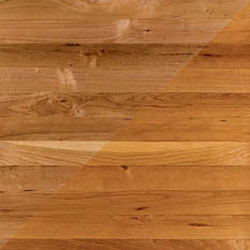
Appearance
American Cherry has a warm medium brownish orange hue with a moderate grain pattern throughout. The natural color of American Cherry will darken to the exposure of light more noticeably than other woods.
Hardness
26% softer than Red Oak
Hardness is figured by how much the wood will dent when something is dropped.
Stability
33% more stable than Red Oak
Stability is figured by how well a wood can combat separation and contraction during the changing of the seasons.
American Cherry has a warm medium brownish orange hue with a moderate grain pattern throughout. The natural color of American Cherry will darken to the exposure of light more noticeably than other woods.
Hardness
26% softer than Red Oak
Hardness is figured by how much the wood will dent when something is dropped.
Stability
33% more stable than Red Oak
Stability is figured by how well a wood can combat separation and contraction during the changing of the seasons.
American Walnut
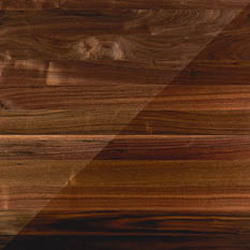
AppearanceAmerican Walnut has a dark, rich brown hue with noticeable light sapwood content unlike most woods. The graining of American Walnut is minimal but can differ from a straight grain to a curled grain throughout the floor.
Hardness
22% softer than Red Oak
Hardness is figured by how much the wood will dent when something is dropped.
Stability
26% more stable than Red Oak
Stability is figured by how well a wood can combat separation and contraction during the changing of the seasons.
Hardness
22% softer than Red Oak
Hardness is figured by how much the wood will dent when something is dropped.
Stability
26% more stable than Red Oak
Stability is figured by how well a wood can combat separation and contraction during the changing of the seasons.
Ash
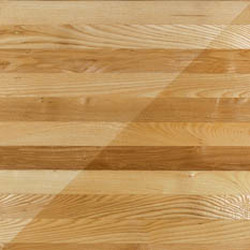
Appearance
Ash has a natural light yellow hue with a distinctive grain pattern throughout. The graining of Ash is a creamy white hue which makes daily wear and scratching less noticeable. Ash allows the stain to accept more of an intense even color throughout the floor.
Hardness
2% harder than Red Oak
Hardness is figured by how much the wood will dent when something is dropped.
Stability
26% more stable than Red Oak
Stability is figured by how well a wood can combat separation and contraction during the changing of the seasons.
Ash has a natural light yellow hue with a distinctive grain pattern throughout. The graining of Ash is a creamy white hue which makes daily wear and scratching less noticeable. Ash allows the stain to accept more of an intense even color throughout the floor.
Hardness
2% harder than Red Oak
Hardness is figured by how much the wood will dent when something is dropped.
Stability
26% more stable than Red Oak
Stability is figured by how well a wood can combat separation and contraction during the changing of the seasons.
Australian Cypress
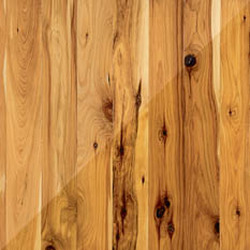
Appearance
Australian Cypress has a golden brown hue with darker knot holes throughout. With any grade of Australian Cypress there is a high amount of color variability throughout the wood.
Hardness
6% harder than Red Oak
Hardness is figured by how much the wood will dent when something is dropped.
Stability
56% more stable than Red Oak
Stability is figured by how well a wood can combat separation and contraction during the changing of the seasons.
Australian Cypress has a golden brown hue with darker knot holes throughout. With any grade of Australian Cypress there is a high amount of color variability throughout the wood.
Hardness
6% harder than Red Oak
Hardness is figured by how much the wood will dent when something is dropped.
Stability
56% more stable than Red Oak
Stability is figured by how well a wood can combat separation and contraction during the changing of the seasons.
Beech
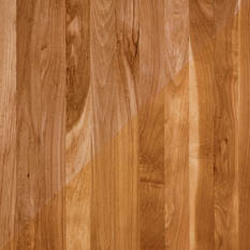
Appearance
Beech has a very pale to reddish brown hue with a moderate grain pattern throughout. The graining of Beech is more uniform throughout the floor than most woods.
Hardness
1% harder than Red Oak
Hardness is figured by how much the wood will dent when something is dropped.
Stability
17% less stable than Red Oak
Stability is figured by how well a wood can combat separation and contraction during the changing of the seasons.
Beech has a very pale to reddish brown hue with a moderate grain pattern throughout. The graining of Beech is more uniform throughout the floor than most woods.
Hardness
1% harder than Red Oak
Hardness is figured by how much the wood will dent when something is dropped.
Stability
17% less stable than Red Oak
Stability is figured by how well a wood can combat separation and contraction during the changing of the seasons.
Birch
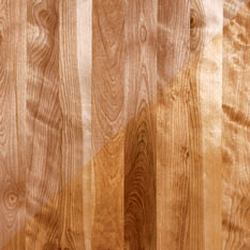
Appearance
Birch has a pale to light tan hue with a moderate grain pattern throughout. With Birch’s light color and minimal grain pattern this flooring is often confused with Maple flooring.
Hardness
2% softer than Red Oak
Hardness is figured by how much the wood will dent when something is dropped.
Stability
8% more stable than Red Oak
Stability is figured by how well a wood can combat separation and contraction during the changing of the seasons.
Birch has a pale to light tan hue with a moderate grain pattern throughout. With Birch’s light color and minimal grain pattern this flooring is often confused with Maple flooring.
Hardness
2% softer than Red Oak
Hardness is figured by how much the wood will dent when something is dropped.
Stability
8% more stable than Red Oak
Stability is figured by how well a wood can combat separation and contraction during the changing of the seasons.
Brazilian Cherry
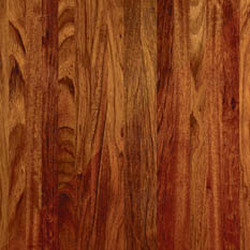
Appearance
Brazilian Cherry has a light reddish orange hue when initially installed but over time will have a dark rich reddish brown hue with a moderate grain pattern throughout. Brazilian Cherry displays a large range of color variation unlike most wood flooring. Brazilian Cherry is very light-sensitive throughout the life of the floor.
Hardness
82% harder than Red Oak
Hardness is figured by how much the wood will dent when something is dropped.
Stability
19% more stable than Red Oak
Stability is figured by how well a wood can combat separation and contraction during the changing of the seasons.
Brazilian Cherry has a light reddish orange hue when initially installed but over time will have a dark rich reddish brown hue with a moderate grain pattern throughout. Brazilian Cherry displays a large range of color variation unlike most wood flooring. Brazilian Cherry is very light-sensitive throughout the life of the floor.
Hardness
82% harder than Red Oak
Hardness is figured by how much the wood will dent when something is dropped.
Stability
19% more stable than Red Oak
Stability is figured by how well a wood can combat separation and contraction during the changing of the seasons.
Brazilian Walnut
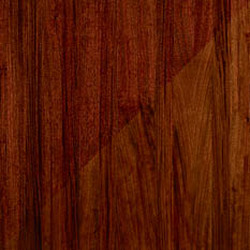
Appearance
Brazilian Walnut has light tan, medium brown and greenish hue when initially installed but over time will have a medium to dark brown hue with an irregular grain pattern throughout. Brazilian Walnut displays a large range of color variation unlike most wood flooring. The natural hue of Brazilian Walnut will darken to the exposure of light more noticeably than other woods.
Hardness
185% harder than Red Oak
Hardness is figured by how much the wood will dent when something is dropped.
Stability
7% more stable than Red Oak
Stability is figured by how well a wood can combat separation and contraction during the changing of the seasons.
Brazilian Walnut has light tan, medium brown and greenish hue when initially installed but over time will have a medium to dark brown hue with an irregular grain pattern throughout. Brazilian Walnut displays a large range of color variation unlike most wood flooring. The natural hue of Brazilian Walnut will darken to the exposure of light more noticeably than other woods.
Hardness
185% harder than Red Oak
Hardness is figured by how much the wood will dent when something is dropped.
Stability
7% more stable than Red Oak
Stability is figured by how well a wood can combat separation and contraction during the changing of the seasons.
Heart Pine
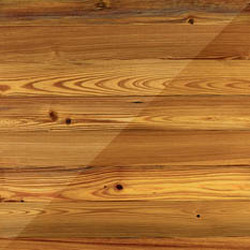
Appearance
Heart Pine has a yellow hue when initially installed but over time will have a medium reddish brown hue. The color change in Heart Pine is due to the high amount of resin that this wood contains. Heart Pine has a predominant wood grain and is often reclaimed wood when installed.
Hardness
5% softer than Red Oak
Hardness is figured by how much the wood will dent when something is dropped.
Stability
29% more stable than Red Oak
Stability is figured by how well a wood can combat separation and contraction during the changing of the seasons.
Heart Pine has a yellow hue when initially installed but over time will have a medium reddish brown hue. The color change in Heart Pine is due to the high amount of resin that this wood contains. Heart Pine has a predominant wood grain and is often reclaimed wood when installed.
Hardness
5% softer than Red Oak
Hardness is figured by how much the wood will dent when something is dropped.
Stability
29% more stable than Red Oak
Stability is figured by how well a wood can combat separation and contraction during the changing of the seasons.
Hickory
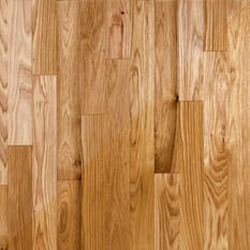
Appearance
Hickory has both a light cream to a medium brown hue with variations in color throughout. Hickory has multiple grades of differing character than most woods.
Hardness
41% harder than Red Oak
Hardness is figured by how much the wood will dent when something is dropped.
Stability
11% less stable than Red Oak
Stability is figured by how well a wood can combat separation and contraction during the changing of the seasons.
Hickory has both a light cream to a medium brown hue with variations in color throughout. Hickory has multiple grades of differing character than most woods.
Hardness
41% harder than Red Oak
Hardness is figured by how much the wood will dent when something is dropped.
Stability
11% less stable than Red Oak
Stability is figured by how well a wood can combat separation and contraction during the changing of the seasons.
Maple
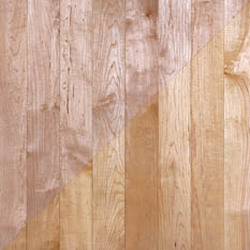
Appearance
Maple has a pale to light tan hue with very minimal grain pattern throughout. Maple does not stain well and the color will look uneven and blotchy throughout the floor.
Hardness
12% harder than Red Oak
Hardness is figured by how much the wood will dent when something is dropped.
Stability
4% more stable than Red Oak
Stability is figured by how well a wood can combat separation and contraction during the changing of the seasons.
Maple has a pale to light tan hue with very minimal grain pattern throughout. Maple does not stain well and the color will look uneven and blotchy throughout the floor.
Hardness
12% harder than Red Oak
Hardness is figured by how much the wood will dent when something is dropped.
Stability
4% more stable than Red Oak
Stability is figured by how well a wood can combat separation and contraction during the changing of the seasons.
Red Oak
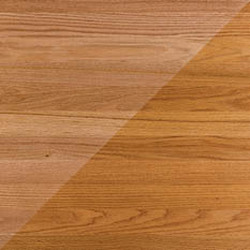
Appearance
Red Oak has a light pinkish tan to a medium brown hue and a predominant grain pattern throughout. The predominant graining of Red Oak allows this wood to hide daily wear and scratching more than other woods. Red Oak also accepts stain more evenly than other woods. Red Oak is commonly used as a standard for most builders and remodelers.
Hardness
Benchmark for hardness of other species.
Stability
Benchmark for stability of other species.
Red Oak has a light pinkish tan to a medium brown hue and a predominant grain pattern throughout. The predominant graining of Red Oak allows this wood to hide daily wear and scratching more than other woods. Red Oak also accepts stain more evenly than other woods. Red Oak is commonly used as a standard for most builders and remodelers.
Hardness
Benchmark for hardness of other species.
Stability
Benchmark for stability of other species.
White Oak
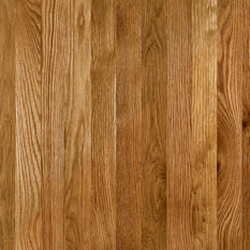
Appearance
White Oak has a light brown to a dull gray hue and a moderate grain pattern throughout. The variations in color and graining are noticeable in White Oak, but not as noticeable as in Red Oak.
Hardness
5% harder than Red Oak
Hardness is figured by how much the wood will dent when something is dropped.
Stability
1% more stable than Red Oak
Stability is figured by how well a wood can combat separation and contraction during the changing of the seasons.
White Oak has a light brown to a dull gray hue and a moderate grain pattern throughout. The variations in color and graining are noticeable in White Oak, but not as noticeable as in Red Oak.
Hardness
5% harder than Red Oak
Hardness is figured by how much the wood will dent when something is dropped.
Stability
1% more stable than Red Oak
Stability is figured by how well a wood can combat separation and contraction during the changing of the seasons.
Santos Mahogany
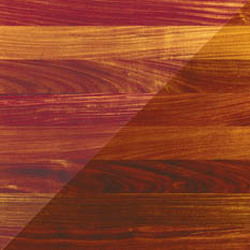
Appearance
Santos Mahogany has a warm reddish brown hue and moderate grain pattern throughout. The natural color of Santos Mahogany will darken to the exposure of light more noticeably than other woods.
Hardness
71% harder than Red Oak
Hardness is figured by how much the wood will dent when something is dropped.
Stability
36% more stable than Red Oak
Stability is figured by how well a wood can combat separation and contraction during the changing of the seasons.
Santos Mahogany has a warm reddish brown hue and moderate grain pattern throughout. The natural color of Santos Mahogany will darken to the exposure of light more noticeably than other woods.
Hardness
71% harder than Red Oak
Hardness is figured by how much the wood will dent when something is dropped.
Stability
36% more stable than Red Oak
Stability is figured by how well a wood can combat separation and contraction during the changing of the seasons.
Sapele
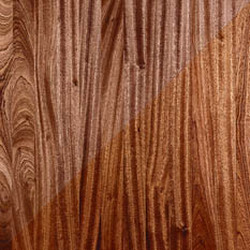
Appearance
Sapele has a rich reddish brown hue and a moderate grain pattern throughout. Sapele’s unique ribbon like grain is not similar to most woods.
Hardness
16% harder than Red Oak
Hardness is figured by how much the wood will dent when something is dropped.
Stability
14% more stable than Red Oak
Stability is figured by how well a wood can combat separation and contraction during the changing of the seasons.
Sapele has a rich reddish brown hue and a moderate grain pattern throughout. Sapele’s unique ribbon like grain is not similar to most woods.
Hardness
16% harder than Red Oak
Hardness is figured by how much the wood will dent when something is dropped.
Stability
14% more stable than Red Oak
Stability is figured by how well a wood can combat separation and contraction during the changing of the seasons.
Spotted Gum

Appearance
Spotted Gum has a light tan to dark brown hue with moderate grain pattern throughout. Spotted Gum has noticeable color variation and diverse grain pattern throughout the floor that differs from most woods.
Hardness
92% harder than Red Oak
Hardness is figured by how much the wood will dent when something is dropped.
Stability
Not Available
Spotted Gum has a light tan to dark brown hue with moderate grain pattern throughout. Spotted Gum has noticeable color variation and diverse grain pattern throughout the floor that differs from most woods.
Hardness
92% harder than Red Oak
Hardness is figured by how much the wood will dent when something is dropped.
Stability
Not Available

